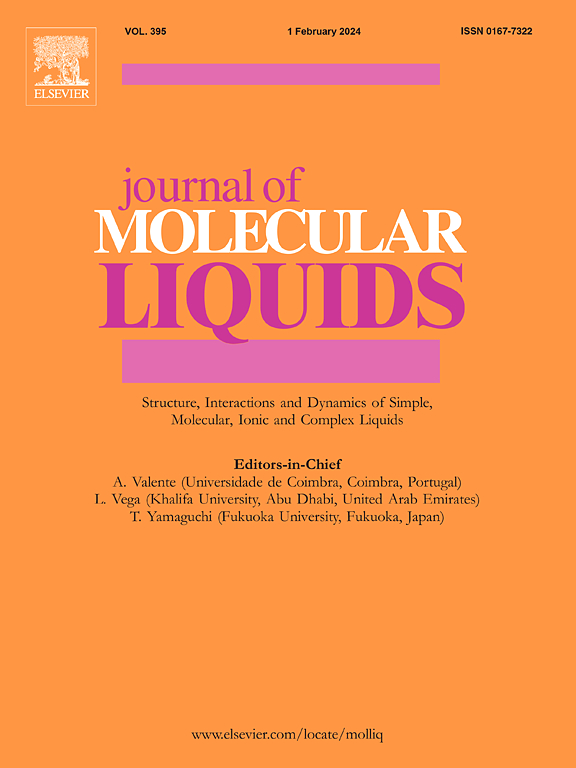Preparation, characterization, and adsorption mechanism of cogon grass-derived cellulose nanofibers/graphene nanoplatelets aerogels for diclofenac sodium removal from water
IF 5.3
2区 化学
Q2 CHEMISTRY, PHYSICAL
引用次数: 0
Abstract
The presence of diclofenac sodium (DCF) residues in water streams poses significant risks to aquatic ecosystems and human health. The ecotoxicity of pharmaceutical contaminants can be mitigated by developing advanced materials to supplement conventional wastewater treatment methods. This study aims to prepare and characterize the physicochemical properties of cogon grass-based cellulose nanofibers/graphene nanoplatelets (CNF/GnP) aerogels for the removal of DCF residues from aqueous solutions. CNF was successfully isolated from cogon grass through a series of processes, including bleaching, alkaline treatment, and TEMPO-mediated oxidation, followed by mechanical disintegration. Fourier Transform Infrared Spectroscopy (FTIR) revealed the composition of CNF and indicated the presence of physical crosslinking with GnP. Scanning Electron Microscopy (SEM) and Transmission Electron Microscopy (TEM) confirmed CNF diameters ranging from 1.1 to 5.3 nm. Thermogravimetric analysis (TGA) demonstrated an increase in thermal stability from raw cellulose (269.94 °C) to CNF aerogel (296.96 °C) and CNF/GnP aerogel (309.45 °C). Both CNF aerogel and CNF/GnP aerogel were applied for the adsorption of DCF. The adsorption capacity and removal efficiency of CNF/GnP aerogel (219.3 mg/g and 95.47 %) were comparable to those of CNF aerogel (204.2 mg/g and 88.81 %) under optimal conditions: pH 4, 0.045 g adsorbent dosage, and an initial DCF concentration of 10 mg/L, indicating that the CNF matrix plays a significant role in the adsorption process. The adsorption behaviour followed the Langmuir isotherm and pseudo-second-order kinetic models. This study demonstrates the potential of CNF aerogel and CNF/GnP aerogel as sustainable adsorbents for DCF removal, contributing to the development of green technologies in alignment with Sustainable Development Goals.

求助全文
约1分钟内获得全文
求助全文
来源期刊

Journal of Molecular Liquids
化学-物理:原子、分子和化学物理
CiteScore
10.30
自引率
16.70%
发文量
2597
审稿时长
78 days
期刊介绍:
The journal includes papers in the following areas:
– Simple organic liquids and mixtures
– Ionic liquids
– Surfactant solutions (including micelles and vesicles) and liquid interfaces
– Colloidal solutions and nanoparticles
– Thermotropic and lyotropic liquid crystals
– Ferrofluids
– Water, aqueous solutions and other hydrogen-bonded liquids
– Lubricants, polymer solutions and melts
– Molten metals and salts
– Phase transitions and critical phenomena in liquids and confined fluids
– Self assembly in complex liquids.– Biomolecules in solution
The emphasis is on the molecular (or microscopic) understanding of particular liquids or liquid systems, especially concerning structure, dynamics and intermolecular forces. The experimental techniques used may include:
– Conventional spectroscopy (mid-IR and far-IR, Raman, NMR, etc.)
– Non-linear optics and time resolved spectroscopy (psec, fsec, asec, ISRS, etc.)
– Light scattering (Rayleigh, Brillouin, PCS, etc.)
– Dielectric relaxation
– X-ray and neutron scattering and diffraction.
Experimental studies, computer simulations (MD or MC) and analytical theory will be considered for publication; papers just reporting experimental results that do not contribute to the understanding of the fundamentals of molecular and ionic liquids will not be accepted. Only papers of a non-routine nature and advancing the field will be considered for publication.
 求助内容:
求助内容: 应助结果提醒方式:
应助结果提醒方式:


